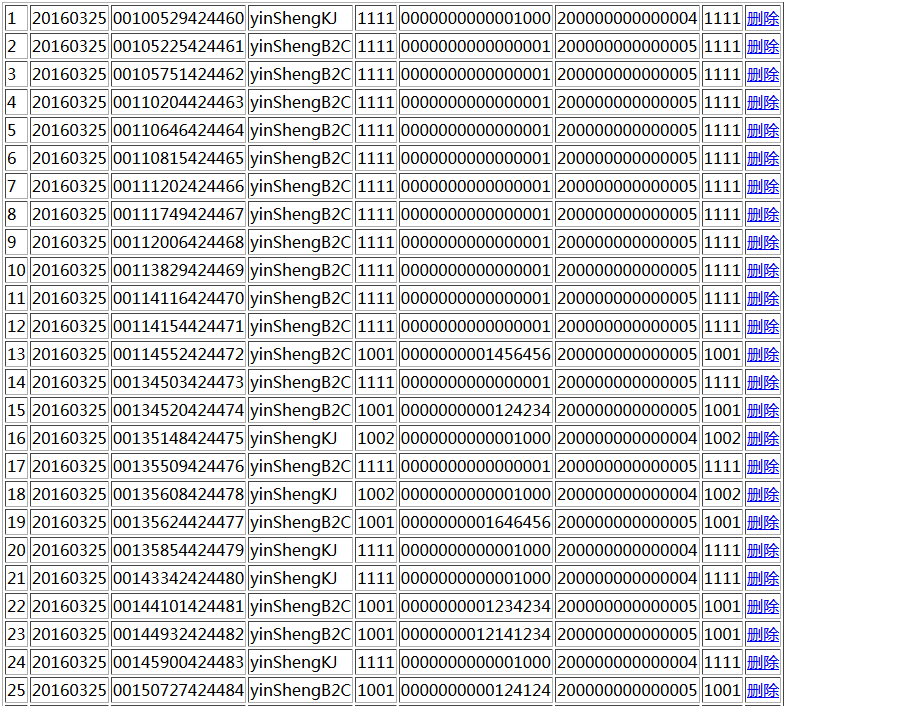redis整合spring mybatis --缓存方案
2017-05-03 13:57
543 查看
一、Spring集成redis
1.在resource目录下创建spring-redis.xml文件,内容如下:
<?xml version="1.0" encoding="UTF-8"?> <beans xmlns="http://www.springframework.org/schema/beans" xmlns:xsi="http://www.w3.org/2001/XMLSchema-instance" xmlns:context="http://www.springframework.org/schema/context" xmlns:p="http://www.springframework.org/schema/p" xsi:schemaLocation="http://www.springframework.org/schema/aop http://www.springframework.org/schema/aop/spring-aop-4.1.xsd http://www.springframework.org/schema/beans http://www.springframework.org/schema/beans/spring-beans-4.1.xsd http://www.springframework.org/schema/context http://www.springframework.org/schema/context/spring-context-4.1.xsd"> <bean id="jedisPoolConfig" class="redis.clients.jedis.JedisPoolConfig"> <property name="maxIdle" value="2000" /> <property name="maxTotal" value="20000" /> <property name="minEvictableIdleTimeMillis" value="300000"></property> <property name="numTestsPerEvictionRun" value="3"></property> <property name="timeBetweenEvictionRunsMillis" value="60000"></property> <property name="maxWaitMillis" value="20000" /> <property name="testOnBorrow" value="false" /> </bean> <bean id="sentinelConfig" class="org.springframework.data.redis.connection.RedisSentinelConfiguration"> <property name="master"> <bean class="org.springframework.data.redis.connection.RedisNode"> <property name="name" value="mymaster"></property> </bean> </property> <property name="sentinels"> <set> <bean class="org.springframework.data.redis.connection.RedisNode"> <constructor-arg name="host" value="192.168.12.90" /> <constructor-arg name="port" value="7505" /> </bean> <bean class="org.springframework.data.redis.connection.RedisNode"> <construct 20000 or-arg name="host" value="192.168.12.90" /> <constructor-arg name="port" value="7506" /> </bean> </set> </property> </bean> <!-- 在此将sentinel配置集成到redis连接池中 --> <bean id="jedisConnectionFactory" class="org.springframework.data.redis.connection.jedis.JedisConnectionFactory"> <property name="timeout" value="20000"></property> <property name="poolConfig" ref="jedisPoolConfig"></property> <constructor-arg name="sentinelConfig" ref="sentinelConfig"></constructor-arg> </bean> <bean id="stringRedisTemplate" class="org.springframework.data.redis.core.StringRedisTemplate"> <property name="connectionFactory" ref="jedisConnectionFactory" /> </bean> </beans>1
2
3
4
5
6
7
8
9
10
11
12
13
14
15
16
17
18
19
20
21
22
23
24
25
26
27
28
29
30
31
32
33
34
35
36
37
38
39
40
41
42
43
44
45
46
47
48
49
50
51
1
2
3
4
5
6
7
8
9
10
11
12
13
14
15
16
17
18
19
20
21
22
23
24
25
26
27
28
29
30
31
32
33
34
35
36
37
38
39
40
41
42
43
44
45
46
47
48
49
50
51
在上述配置中,我们用jedis 池化管理方案,将sentinel纳入配置中去,这样就不用代码中用JedisSentinelPool了,直接用JedisPool就ok了。别忘了,将此文件加入web.xml中:
<context-param> <param-name>contextConfigLocation</param-name> <param-value>classpath:spring-mybatis.xml,classpath:spring-redis.xml</param-value> </context-param>1
2
3
4
1
2
3
4
2.测试
新建测试类,内容如下:package com.dg;
import java.util.Collection;
import java.util.List;
import java.util.Map;
import java.util.Set;
import javax.annotation.Resource;
import org.junit.Test;
import org.junit.runner.RunWith;
import org.springframework.data.redis.connection.RedisSentinelConnection;
import org.springframework.data.redis.connection.RedisServer;
import org.springframework.data.redis.core.StringRedisTemplate;
import org.springframework.test.context.ContextConfiguration;
import org.springframework.test.context.junit4.SpringJUnit4ClassRunner;
import com.alibaba.fastjson.JSONObject;
import com.dg.bean.User;
@RunWith(SpringJUnit4ClassRunner.class)
@ContextConfiguration(locations = { "classpath:spring-redis.xml" })
public class SpringRedis {
@Resource(name = "stringRedisTemplate")
private StringRedisTemplate stringRedisTemplate;
/**
* redis 读写测试
*/
@Test
public void testSpringRedis() {
try {
// ApplicationContext context = new
// ClassPathXmlApplicationContext("spring-redis.xml");
// StringRedisTemplate stringRedisTemplate =
// context.getBean("stringRedisTemplate",
// StringRedisTemplate.class);
// String读写
stringRedisTemplate.delete("myStr");
stringRedisTemplate.opsForValue().set("myStr", "http://yjmyzz.cnblogs.com/");
System.out.println(stringRedisTemplate.opsForValue().get("myStr"));
System.out.println("---------------");
// List读写
stringRedisTemplate.delete("myList");
stringRedisTemplate.opsForList().rightPush("myList", "A");
stringRedisTemplate.opsForList().rightPush("myList", "B");
stringRedisTemplate.opsForList().leftPush("myList", "0");
List<String> listCache = stringRedisTemplate.opsForList().range("myList", 0, -1);
for (String s : listCache) {
System.out.println(s);
}
System.out.println("---------------");
// Set读写
stringRedisTemplate.delete("mySet");
stringRedisTemplate.opsForSet().add("mySet", "A");
stringRedisTemplate.opsForSet().add("mySet", "B");
stringRedisTemplate.opsForSet().add("mySet", "C");
Set<String> setCache = stringRedisTemplate.opsForSet().members("mySet");
for (String s : setCache) {
System.out.println(s);
}
System.out.println("---------------");
// Hash读写
stringRedisTemplate.delete("myHash");
stringRedisTemplate.opsForHash().put("myHash", "PEK", "北京");
stringRedisTemplate.opsForHash().put("myHash", "SHA", "上海虹桥");
stringRedisTemplate.opsForHash().put("myHash", "PVG", "浦东");
Map<Object, Object> hashCache = stringRedisTemplate.opsForHash().entries("myHash");
for (Map.Entry<Object, Object> entry : hashCache.entrySet()) {
System.out.println(entry.getKey() + " - " + entry.getValue());
}
System.out.println("---------------");
} catch (Exception e) {
e.printStackTrace();
}
}
/**
* redis 得到所有的master and slave 信息
*/
@Test
public void testGetAllMasterAndSlave() {
RedisSentinelConnection conn = stringRedisTemplate.getConnectionFactory().getSentinelConnection();
for (RedisServer master : conn.masters()) {
System.out.println("master => " + master);// 打印master信息
Collection<RedisServer> slaves = conn.slaves(master);
// 打印该master下的所有slave信息
for (RedisServer slave : slaves) {
System.out.println("slaves of " + master + " => " + slave);
}
System.out.println("--------------");
}
}
/*
* 测试redis 缓存object 和 list 类型数据(方案:用json将object和list序列化)
*/
@Test
public void testRedisCacheObjectAndList() {
User user1 = new User("zhangsan", "123456", "222888@qq.com", "15824812342", 'M', 22);
// // fastJson 序列化
// String jsonStr = JSONObject.toJSONString(user1);
// System.out.println(">>>>>>>>>>>>>>>>" + jsonStr);
// // fastJson 反序列化
// user1 = JSONObject.parseObject(jsonStr, User.class);
// System.out.println(">>>>>>>>>>>>>>>>>>" + user1);
stringRedisTemplate.delete("user1");
// 将object 用 json 序列化后保存redis
stringRedisTemplate.opsForValue().set("user1", JSONObject.toJSONString(user1));
user1 = JSONObject.parseObject(stringRedisTemplate.opsForValue().get("user1"), User.class);
System.out.println("-----------------------" + user1);
}
}
/**测试redis客户端*/
@Test
public void testRedis(){
Jedis jedis = new Jedis("192.168.12.90", 6379);
jedis.set("name", "mrdg");
jedis.set("age", "24");
System.out.println("name:"+jedis.get("name"));
System.out.println("age:"+jedis.get("age"));
System.out.println("tel:"+jedis.get("Tel"));
System.out.println("no:"+jedis.get("No"));
}
/**测试redis集群方案*/
@Test
public void testCluster(){
Set<HostAndPort> jedisClusterNodes = new HashSet<HostAndPort>();
//Jedis Cluster will attempt to discover cluster nodes automatically
jedisClusterNodes.add(new HostAndPort("192.168.12.90", 7001));
JedisCluster jc = new JedisCluster(jedisClusterNodes);
jc.set("foo", "bar");
String value = jc.get("foo");
System.out.println(value);
try {
jc.close();
} catch (Exception e) {
e.printStackTrace();
}
}12
3
4
5
6
7
8
9
10
11
12
13
14
15
16
17
18
19
20
21
22
23
24
25
26
27
28
29
30
31
32
33
34
35
36
37
38
39
40
41
42
43
44
45
46
47
48
49
50
51
52
53
54
55
56
57
58
59
60
61
62
63
64
65
66
67
68
69
70
71
72
73
74
75
76
77
78
79
80
81
82
83
84
85
86
87
88
89
90
91
92
93
94
95
96
97
98
99
100
101
102
103
104
105
106
107
108
109
110
111
112
113
114
115
116
117
118
119
120
121
122
123
124
125
126
127
128
129
130
131
132
133
134
135
136
137
138
139
140
141
142
143
144
145
146
147
148
149
150
151
152
153
154
155
1
2
3
4
5
6
7
8
9
10
11
12
13
14
15
16
17
18
19
20
21
22
23
24
25
26
27
28
29
30
31
32
33
34
35
36
37
38
39
40
41
42
43
44
45
46
47
48
49
50
51
52
53
54
55
56
57
58
59
60
61
62
63
64
65
66
67
68
69
70
71
72
73
74
75
76
77
78
79
80
81
82
83
84
85
86
87
88
89
90
91
92
93
94
95
96
97
98
99
100
101
102
103
104
105
106
107
108
109
110
111
112
113
114
115
116
117
118
119
120
121
122
123
124
125
126
127
128
129
130
131
132
133
134
135
136
137
138
139
140
141
142
143
144
145
146
147
148
149
150
151
152
153
154
155
上面的测试类,cluster方案集群环境为(详见http://blog.csdn.net/donggang1992/article/details/50981954):

sentinel方案环境为(详见http://blog.csdn.net/donggang1992/article/details/50981341):

二、mybatis集成redis进行缓存配置
1.mybatis开启缓存支持
在spring-mabatis.xml中添加下列内容:<!-- spring和MyBatis完美整合,不需要mybatis的配置映射文件 --> <bean id="sqlSessionFactory" class="org.mybatis.spring.SqlSessionFactoryBean"> <property name="dataSource" ref="dataSource" /> <!-- 自动扫描mapping.xml文件 --> <property name="mapperLocations" value="classpath:com/dg/mapping/*.xml"></property> <!-- 开启缓存支持 --> <property name="configurationProperties"> <props> <prop key="cacheEnabled">true</prop> <!-- 查询时,关闭关联对象即时加载以提高性能 --> <prop key="lazyLoadingEnabled">false</prop> <!-- 设置关联对象加载的形态,此处为按需加载字段(加载字段由SQL指定),不会加载关联表的所有字段,以提高性能 --> <prop key="aggressiveLazyLoading">true</prop> <!-- 对于未知的SQL查询,允许返回不同的结果集以达到通用的效果 --> <prop key="multipleResultSetsEnabled">true</prop> <!-- 允许使用列标签代替列名 --> <prop key="useColumnLabel">true</prop> <!-- 允许使用自定义的主键值(比如由程序生成的UUID 32位编码作为键值),数据表的PK生成策略将被覆盖 --> <prop key="useGeneratedKeys">true</prop> <!-- 给予被嵌套的resultMap以字段-属性的映射支持 --> <prop key="autoMappingBehavior">FULL</prop> <!-- 对于批量更新操作缓存SQL以提高性能 --> <prop key="defaultExecutorType">BATCH</prop> <!-- 数据库超过25000秒仍未响应则超时 --> <prop key="defaultStatementTimeout">25000</prop> </props> </property> </bean>1
2
3
4
5
6
7
8
9
10
11
12
13
14
15
16
17
18
19
20
21
22
23
24
25
26
27
28
1
2
3
4
5
6
7
8
9
10
11
12
13
14
15
16
17
18
19
20
21
22
23
24
25
26
27
28
2.新建cache包,并创建RedisCache类
RedisCache类的内容为:package com.dg.cache;
import java.util.Set;
import java.util.concurrent.locks.ReadWriteLock;
import java.util.concurrent.locks.ReentrantReadWriteLock;
import org.apache.commons.codec.digest.DigestUtils;
import org.apache.ibatis.cache.Cache;
import org.slf4j.Logger;
import org.slf4j.LoggerFactory;
import org.springframework.context.ApplicationContext;
import org.springframework.context.support.ClassPathXmlApplicationContext;
import com.dg.util.SerializeUtil;
import redis.clients.jedis.Jedis;
import redis.clients.jedis.JedisPool;
import redis.clients.jedis.JedisPoolConfig;
/*
* 使用第三方缓存服务器,处理二级缓存
*/
public class RedisCache implements Cache {
private static Logger logger = LoggerFactory.getLogger(RedisCache.class);
/** The ReadWriteLock. */
private final ReadWriteLock readWriteLock = new ReentrantReadWriteLock();
private String id;
private JedisPool jedisPool;
private static final int DB_INDEX = 1;
private final String COMMON_CACHE_KEY = "COM:";
private static final String UTF8 = "utf-8";
private ApplicationContext context;
/**
* 按照一定规则标识key
*/
private String getKey(Object key) {
StringBuilder accum = new StringBuilder();
accum.append(COMMON_CACHE_KEY);
accum.append(this.id).append(":");
accum.append(DigestUtils.md5Hex(String.valueOf(key)));
return accum.toString();
}
/**
* redis key规则前缀
*/
private String getKeys() {
return COMMON_CACHE_KEY + this.id + ":*";
}
public RedisCache() {
}
public RedisCache(final String id) {
if (id == null) {
throw new IllegalArgumentException("必须传入ID");
}
context = new ClassPathXmlApplicationContext("spring-redis.xml");
JedisPoolConfig jedisPoolConfig = (JedisPoolConfig) context.getBean("jedisPoolConfig");
jedisPool = new JedisPool(jedisPoolConfig, "192.168.12.90", 7504);
logger.debug(">>>>>>>>>>>>>>>>>>>>>MybatisRedisCache:id=" + id);
this.id = id;
}
@Override
public String getId() {
return this.id;
}
@Override
public int getSize() {
Jedis jedis = null;
int result = 0;
boolean borrowOrOprSuccess = true;
try {
jedis = jedisPool.getResource();
jedis.select(DB_INDEX);
Set<byte[]> keys = jedis.keys(getKeys().getBytes(UTF8));
if (null != keys && !keys.isEmpty()) {
result = keys.size();
}
logger.debug(this.id + "---->>>>总缓存数:" + result);
} catch (Exception e) {
borrowOrOprSuccess = false;
if (jedis != null)
jedisPool.returnBrokenResource(jedis);
} finally {
if (borrowOrOprSuccess)
jedisPool.returnResource(jedis);
}
return result;
}
@Override
public void putObject(Object key, Object value) {
Jedis jedis = null;
boolean borrowOrOprSuccess = true;
try {
jedis = jedisPool.getResource();
jedis.select(DB_INDEX);
byte[] keys = getKey(key).getBytes(UTF8);
jedis.set(keys, SerializeUtil.serialize(value));
logger.debug("添加缓存--------" + this.id);
// getSize();
} catch (Exception e) {
borrowOrOprSuccess = false;
if (jedis != null)
jedisPool.returnBrokenResource(jedis);
} finally {
if (borrowOrOprSuccess)
jedisPool.returnResource(jedis);
}
}
@Override
public Object getObject(Object key) {
Jedis jedis = null;
Object value = null;
boolean borrowOrOprSuccess = true;
try {
jedis = jedisPool.getResource();
jedis.select(DB_INDEX);
value = SerializeUtil.unserialize(jedis.get(getKey(key).getBytes(UTF8)));
logger.debug("从缓存中获取-----" + this.id);
// getSize();
} catch (Exception e) {
borrowOrOprSuccess = false;
if (jedis != null)
jedisPool.returnBrokenResource(jedis);
} finally {
if (borrowOrOprSuccess)
jedisPool.returnResource(jedis);
}
return value;
}
@Override
public Object removeObject(Object key) {
Jedis jedis = null;
Object value = null;
boolean borrowOrOprSuccess = true;
try {
jedis = jedisPool.getResource();
jedis.select(DB_INDEX);
value = jedis.del(getKey(key).getBytes(UTF8));
logger.debug("LRU算法从缓存中移除-----" + this.id);
// getSize();
} catch (Exception e) {
borrowOrOprSuccess = false;
if (jedis != null)
jedisPool.returnBrokenResource(jedis);
} finally {
if (borrowOrOprSuccess)
jedisPool.returnResource(jedis);
}
return value;
}
@Override
public void clear() {
Jedis jedis = null;
boolean borrowOrOprSuccess = true;
try {
jedis = jedisPool.getResource();
jedis.select(DB_INDEX);
// 如果有删除操作,会影响到整个表中的数据,因此要清空一个mapper的缓存(一个mapper的不同数据操作对应不同的key)
Set<byte[]> keys = jedis.keys(getKeys().getBytes(UTF8));
logger.debug("出现CUD操作,清空对应Mapper缓存======>" + keys.size());
for (byte[] key : keys) {
jedis.del(key);
}
// 下面是网上流传的方法,极大的降低系统性能,没起到加入缓存应有的作用,这是不可取的。
// jedis.flushDB();
// jedis.flushAll();
} catch (Exception e) {
borrowOrOprSuccess = false;
if (jedis != null)
jedisPool.returnBrokenResource(jedis);
} finally {
if (borrowOrOprSuccess)
jedisPool.returnResource(jedis);
}
}
@Override
public ReadWriteLock getReadWriteLock() {
return readWriteLock;
}
}12
3
4
5
6
7
8
9
10
11
12
13
14
15
16
17
18
19
20
21
22
23
24
25
26
27
28
29
30
31
32
33
34
35
36
37
38
39
40
41
42
43
44
45
46
47
48
49
50
51
52
53
54
55
56
57
58
59
60
61
62
63
64
65
66
67
68
69
70
71
72
73
74
75
76
77
78
79
80
81
82
83
84
85
86
87
88
89
90
91
92
93
94
95
96
97
98
99
100
101
102
103
104
105
106
107
108
109
110
111
112
113
114
115
116
117
118
119
120
121
122
123
124
125
126
127
128
129
130
131
132
133
134
135
136
137
138
139
140
141
142
143
144
145
146
147
148
149
150
151
152
153
154
155
156
157
158
159
160
161
162
163
164
165
166
167
168
169
170
171
172
173
174
175
176
177
178
179
180
181
182
183
184
185
186
187
188
189
190
191
192
193
194
195
1
2
3
4
5
6
7
8
9
10
11
12
13
14
15
16
17
18
19
20
21
22
23
24
25
26
27
28
29
30
31
32
33
34
35
36
37
38
39
40
41
42
43
44
45
46
47
48
49
50
51
52
53
54
55
56
57
58
59
60
61
62
63
64
65
66
67
68
69
70
71
72
73
74
75
76
77
78
79
80
81
82
83
84
85
86
87
88
89
90
91
92
93
94
95
96
97
98
99
100
101
102
103
104
105
106
107
108
109
110
111
112
113
114
115
116
117
118
119
120
121
122
123
124
125
126
127
128
129
130
131
132
133
134
135
136
137
138
139
140
141
142
143
144
145
146
147
148
149
150
151
152
153
154
155
156
157
158
159
160
161
162
163
164
165
166
167
168
169
170
171
172
173
174
175
176
177
178
179
180
181
182
183
184
185
186
187
188
189
190
191
192
193
194
195
然后,在mapper文件中添加下列一行使对应的表添加缓存支持:
<cache eviction="LRU" type="com.dg.cache.RedisCache" />1
1
我是以订单表数据作为缓存目标的(通常我们只是对不常变动的数据进行缓存,如登陆用户信息、系统业务配置信息等,这里我用订单表只是作为范例),应用结构如下:

3.测试
测试缓存的话,我们建一个页面,然后查询日期范围的订单列表,如下效果: 
看输出的日志:

可以看出,初次查询的时候,有sql语句,将订单列表查询出之后放入了缓存中去;返回来在执行刚才的查询动作时,只有下面的输出,说明第二次没再查库,而是直接从redis缓存中去取。

结果列表为:

以上只是简单介绍了redis和ssm的整合过程,如果需要完整的代码,到http://download.csdn.net/detail/donggang1992/9481612 下载。
相关文章推荐
- redis整合spring mybatis --缓存方案
- redis整合spring mybatis --缓存方案
- redis整合spring mybatis --缓存方案
- redis整合spring mybatis -- 缓存方案
- mybatis + spring + redis(二级缓存)整合
- spring,springmvc,mybatis整合redis,redis作为缓存使用
- Redis入门很简单之九【SpringMvc+Mybatis与redis整合让Mybatis管理缓存】
- Spring+Redis+MyBatis实现缓存整合
- spring 整合mybatis后用不上session缓存的原因分析
- Spring Boot学习之整合Redis实现缓存
- spring与redis集成之aop整合方案
- spring boot 整合mybatis,redis,热部署
- Mybatis(3、延迟加载、查询缓存、与ehcache整合、逆向工程、与spring整合)
- Redis整合Spring结合使用缓存实例
- SpringBoot整合mybatis、shiro、redis实现基于数据库的细粒度动态权限管理系统实例
- Spring + mybatis整合方案总结 结合实例应用
- spring-boot整合redis作为缓存(2)——spring-boot的缓存
- spring整合redis自动缓存管理
- spring整合redis客户端及缓存接口设计
- Redis整合Spring结合使用缓存实例
